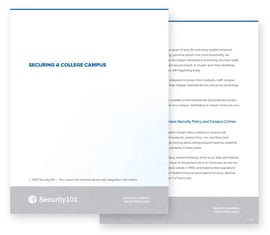
September is National Campus Safety Awareness Month and since security is a rather intimidating and complex topic, Security 101 is here to help educational institutions understand how they can take proactive steps to mitigate campus crime.
College is supposed to be the best four years of your life and every student deserves a safe environment that fosters learning, personal growth and most importantly, fun. Unfortunately, the rate of violent crimes on college campuses is increasing and have sadly become a regular part of the news. From sexual assault, to murder and mass shootings, horrific crimes causing grave impact are still happening today.
Failure to consider environmental risk and protective factors for individuals, the institution and the community can lead to devastating acts of violence on a college campus. And failure to report crimes can now result in financial fines.
Jeanne Clery Disclosure of Campus Security Policy and Campus Crimes Statistics Act
On April 5, 1986, Lehigh University student Josoph Henry entered a campus hall of residence and brutally attacked and murdered Jeanne Clery. Her dormitory had accumulated 181 incident reports of auto-locking doors being propped open by residents and 38 violent crimes recorded at the university in three years.
Clery’s parents, Howard and Connie Clery, worked tirelessly at the local, state and national level to craft legislation to address the issue of unreported crime on campuses across the country. The “Clery Act” became a federal statute in 1990 and implemented regulations that require every school participating in federal financial aid programs to keep, disclose and publish security reports by October 1 of every year.
This report is required to provide crime statistics for the prior three years, policy statements regarding various safety and security measures, campus crime prevention program descriptions, and procedures to be followed in the investigation and prosecution of alleged sex offenses. In addition, the Clery Act requires institutions to give timely warnings of crimes that represent a threat to the safety of students or employees.
The guidelines and expectations for campus crime classification and reporting, crime prevention and response, and campus safety policy and procedure requirements resulting from the Clery Act create transparency between institutions of higher education, students and employees. If an institution fails to meet these requirements, fines ranging from $35,000 per violation up to a recorded $375,000 are authorized for assessment.
Common Campus Safety Concerns
- Disparate access control, video surveillance, lighting, fire safety and emergency notification technology systems
- Vast campuses with ineffective security patrol procedures and video monitoring solutions
- Soft points of entry with lax perimeter control to address neighboring communities
- Poorly lit buildings, walkways, dormitory surroundings and parking garages on campus with unkempt landscaping that obstructs visibility
- Under-emphasized safety and crime prevention information for students
"Securing a College Campus" Blog Series in October
Throughout the month of October, Security 101 will be publishing a 3-part white paper series. All topicswill focus on how to secure a college campus.

Read our white paper on "Securing a College Campus" for a holistic view on how your educational institution can mitigate threats and vulnerabilities to protect its students, staff and facilities.

